BERGEN-BELSEN, GERMANY







WESTERBORK, THE NEDERLANDS
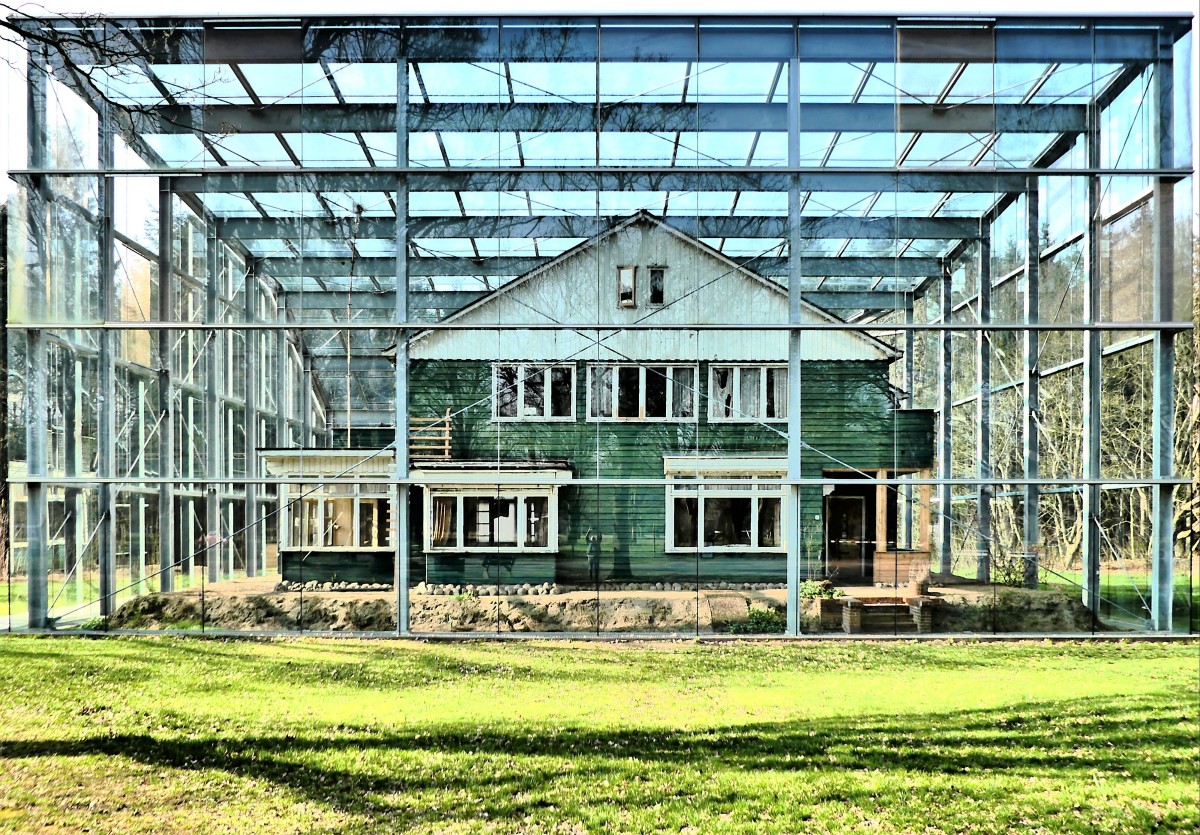





Finding and reporting what's special across America















High up on Hill Street overlooking Glasgow’s valley…
 stands a proper and prominent synagogue, as if telling all concerned, that the Jews of Glasgow are here to stay, and equally deserving of a splendid house of worship to celebrate Shabbat and festivals that can easily compete with a host of surrounding Anglican and Roman churches.
stands a proper and prominent synagogue, as if telling all concerned, that the Jews of Glasgow are here to stay, and equally deserving of a splendid house of worship to celebrate Shabbat and festivals that can easily compete with a host of surrounding Anglican and Roman churches.
The Garnethill Synagogue is Scotland’s oldest, built between 1879 and 1881 with flourishes of Romanesque Revival on the outside,

and Byzantine Revival architecture on the inside…

leading to a grand sanctuary…

once defined by an Orthodox tradition of seating women upstairs, apart from men who prayed downstairs.

But that edict has changed at Garnethill Synagogue for a different reason: there’s simply not enough of a remaining congregation to fill the seats. Men and women are now reunited downstairs, but (thank God) still segregated by sitting on opposite sides, gaining entry through separate doors.
Harvey Kaplan delights in telling me the story of Jewish immigration to Scotland.

For the past 11 years, Harvey has actively advocated for the past. He leads the charge as the director of the Scottish Jewish Archives Centre, an adjunct to the Garnethill Synagogue, working to make Scottish Jewish heritage relevant to a shrinking Scottish Jewish community that now favors bigger Jewish population centers in Manchester and London.
His vision will soon reach fruition thanks to a grant and remodel to be finished by 2020.

I had contacted Harvey earlier in anticipation of my efforts to research of my mother’s journey as a girl through Britain during the Holocaust.
After a tour of the sanctuary, we got down to business. Harvey’s mission to preserve the nation’s Jewish identity became clearer to me as I reflected on my drive to Haddington and Polton earlier in the day.
Before my appointment, I first stopped at Whittingehame House–

–one-time residence of Lord Balfour, Prime Minister, statesman,

and architect of the monumental Balfour Declaration, which granted homesteading rights to Jews in Palestine after Middle Eastern maps were redrawn following WW1.
In the wake of Jewish children seeking refuge in Britain to escape the Nazi scourge, Lord Balfour’s nephew and heir, Viscount Traprain, offered his home and its extensive grounds, surrounded by twisted yew trees,

as a farm school from 1939 to 1941 for teenaged refugees interested in making Aliyah to an Israeli kibbutz in the near future.

I became aware of the change to the estate when I noticed an online ad (https://www.onthemarket.com/details/3579306) detailing a ground floor, 4-bedroom flat with an asking price of £1,850,000. But still, I had to see it for myself.







I’ve just boarded Thomas Cook Flight #2753 from Orlando to Manchester, UK for a 2-week adventure to conduct ancestry research for a book I’m writing (see Uncertainty) that chronicles my mother’s escape from Essen, Germany following Kristallnacht.
Non-stop flight reservations to Manchester were snapped up from Thomas Cook airline (first I’d heard of them) in February for an unbelievably low, inclusive fare of $129…or so I thought.
Little did I realize that my reservation was TraveLite. I discovered during check-in that the airline was assessing me $120 to check my luggage unless it weighed under 6kg. The suitcase empty probably weighed 1 kg.
After composing myself, I gripped the carry handle tightly and I braced myself against the counter as I listened to a potential work-around by the attendant:
“Why not purchase an upgrade from economy to premium class for $125, which also entitles you to one checked bag…and for the extra five bucks, you can enjoy unlimited alcoholic beverages and snacks, 2 premium meals, a wider seat with extra leg room, and priority boarding and priority luggage retrieval for the extra 5 bucks,” she proposed.
My original seat assignment was 42G, the penultimate row next to the toilets.
“Here’s my credit card,” I quickly offered.
“You will now be in 4D,” she announced.
“A no-brainer,” I surmised.

Somehow, I talked myself into believing that paying double was a great deal; yet I was determined to get my money’s worth. After boarding the plane, I delighted in plying through the travel amenities piled high on seat 4D. In addition to an oversized foam pillow–which added an inch of compressed padding to the existing form-fitted seat–there was also a human-sized microfiber blanket in a sanitary wrap, and a zippered vanity bag with all sorts of goodies:

…none of which I used.
A choice of complimentary champagne or orange juice was served in tiny plastic stemware before take-off (but not mimosas, unless one asked for one of each), and premium dinner arrived 45 minutes into the flight…

…consisting of tired chicken breast glazed with a gooey berry syrup beside a peppery mash and a sprig of tawdry broccoli. MEH! Not to be confused with Cathy Pacific or Singapore Air cuisine.
Four tiny bottles of Smirnoff vodka made The Man from U.N.C.L.E. watchable on my video screen, and should have sufficiently prepared me for a nap, but the millenial seated in front of me chose to repose in full recliner- mode, which felt more restrictive than my knee-high compression socks.

The plane landed in Manchester ahead of scheduled arrival time, despite a 40-minute delay. Baggage claim was quick as advertised, and NOBODY was waiting in line for an immigration stamp.

Alamo outfitted me with a Renault Kadjar at the off-campus car rental building.

which required a small adjustment in dexterity and right-side brain coordination.

Left-side shifting on a right-side drive was initially challenging, but negotiating a busy urban roundabout was downright harrowing.
Taking a 1-hour detour to Liverpool’s dockyards…

and neighboring North Park…


before driving 4 overcast hours to Edinburgh proved to be beneficial in normalizing the weird sensation of driving on the wrong/right side of the road.
BTW, this post marks the 2-year bloggiversary for me.

There’s plenty of travel ahead for the year, and I can’t wait to see what’s in store for the future.
Let the adventure continue!

There’s a wall of potty talk that circles the public restroom in the center of St. Augustine’s Old Town on St. George St. It follows a chronology of lavatory achievements through the ages as a testament to shitty innovations in evacuations.
So before you make a big stink and turn a blind eye to an issue this pressing, just cut the crap and log into a blog that offers a fulfilling means to an end:














Society has made major advances in personal hygiene, to the extent that there are deco palaces devoted to pepsic discomfort…

while also allowing for targeted political commentary.

All’s well that ends well!

In celebration of Pi-Day, Leah and I scored theater tickets to the national tour of Waitress, presenting at Times-Union Center in downtown Jacksonville. Wanting to take advantage of fair weather, and never having seen Jacksonville during daylight hours, we decided to make an afternoon of it by visiting the Cummer Museum of Arts and Gardens located in Jacksonville’s Riverside neighborhood, a short distance from our evening venue.

And it was well worth the trip.

In 1902, Arthur Cummer joined his parents, Wellington and Ada at their St. Johns River homestead, and built a half-timber English Tudor style house for Ninah, his bride. Arthur and Ninah began collecting art soon after.
Only the designated Tudor Room remains from the original house, so “the public at large may enjoy some insight into the personality of the owner.”

A series of interconnected museum wings are separated by a courtyard paved with terra-cotta tiles from the Cummer’s old roof.

The original Cummer collection plus acquired collections of paintings, sculptures, and Meissen porcelain fill fourteen galleries, span 3200 years, and range from:
2100 BCE…

to 100 CE…

to 13th century…

to 17th century…

to 18th century…

to 19th century…

…to contemporary artists like Harlem Renaissance sculptor, Augusta Savage, whose work is currently exhibiting in the Mason Gallery.

Following Arthur Cummer’s death in 1943, Ninah wished to establish a “center for beauty and culture…[for] all of the people” on the residence grounds.

Upon the widow’s death in 1958, the estate and gardens were granted to the DeEtte Holden Cummer Museum Foundation. Soon after, buildings were demolished (with the exception of the Tudor Room) in favor of a state-of-the-art museum that opened in 1961, followed by a detailed restoration of the property’s Italian Garden…

the Olmstead Garden…

and the English Garden–

all of which were added to the National Register of Historic Places in 2010 for outstanding “American landscape design in the first four decades of the twentieth century.”
As northeast Florida’s largest and most significant museum and arts education center housing over 5,000 works of art…

the sky is the limit.
BTW…the show was a tasty morsel about a bittersweet topic.

On the third day of a four-day affair, the 1-mile approach to the Ritz-Carlton Hotel was thoroughly congested. In addition to stand-still traffic, an unbroken chain of cars akimbo were parked on both sides of the grassy shoulder.
A steady stream of walkers of all ages easily out-paced my Ford pickup on the way to the Amelia Island Concours d’Elegance, north Florida’s premier destination for car connoisseurs–and in some cases–car collectors with deep pockets. They have come from around the world to claim bragging rights for owning many of the rarest sporting and cruising motorcars worthy of six to seven-figures.

We mastered the final quarter-mile in 30 minutes. Once past the event entrance, we took a quick right and followed the signs that led us to a string of ad hoc neighborhood parking concessions charging $40 for the day. Fortunately, as I approached the first backyard turn-in, a couple was just claiming their vehicle–leaving an open spot for me.
“Are you kidding?! I’m not paying that kind of money for a parking spot! That’s highway robbery!” announced Leah to me.
“Is it any cheaper down the road?” Leah called out to the attendant/mansion owner.
“It’s the same, but if you’re willing to walk back about 20 minutes, you might be able to park somewhere for half the price,” he offered, “but you need to make up your mind ’cause there’s traffic piling up behind you.
I turned into the lot.
“Location, location, location,” I declared.
The sunny skies were a blessing and a curse. The weather was perfect for strolling along the 1st, 10th, and 18th fairways of the Golf Club of Amelia Island…

to gaze at more than 400 classic and exotic automobiles.

However, the owners who were standing guard over their prized possessions were invariably hard at work, answering questions, overstating their cars’ value, and forever polishing away the glaring fingerprints of so many gawkers-turned-touchers.

A full representation of cars from every manufacturer was mostly categorized by brand, ranging from Datsuns…

to Porsches…

with occasional support provided by corporate tents and stages…

showcasing concept cars…




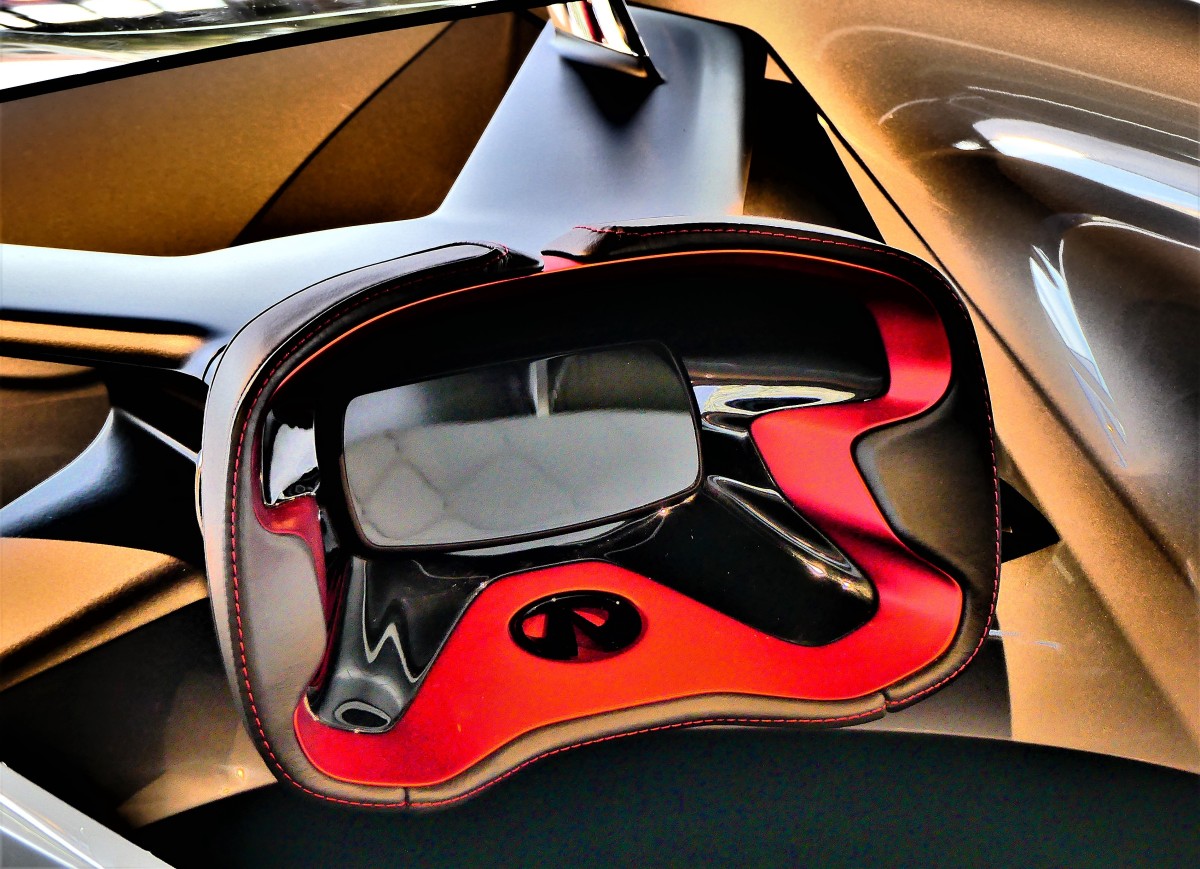
elite production models,


and vintage heirlooms.

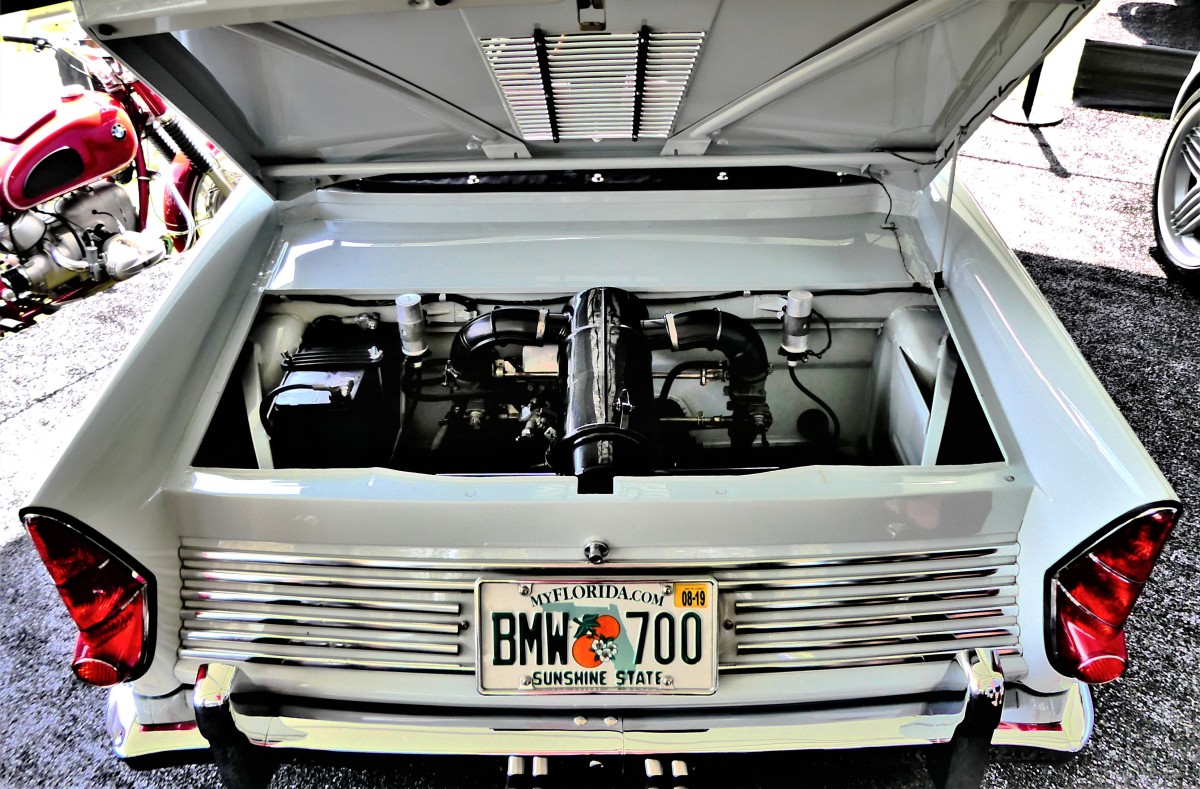
There were novelties…


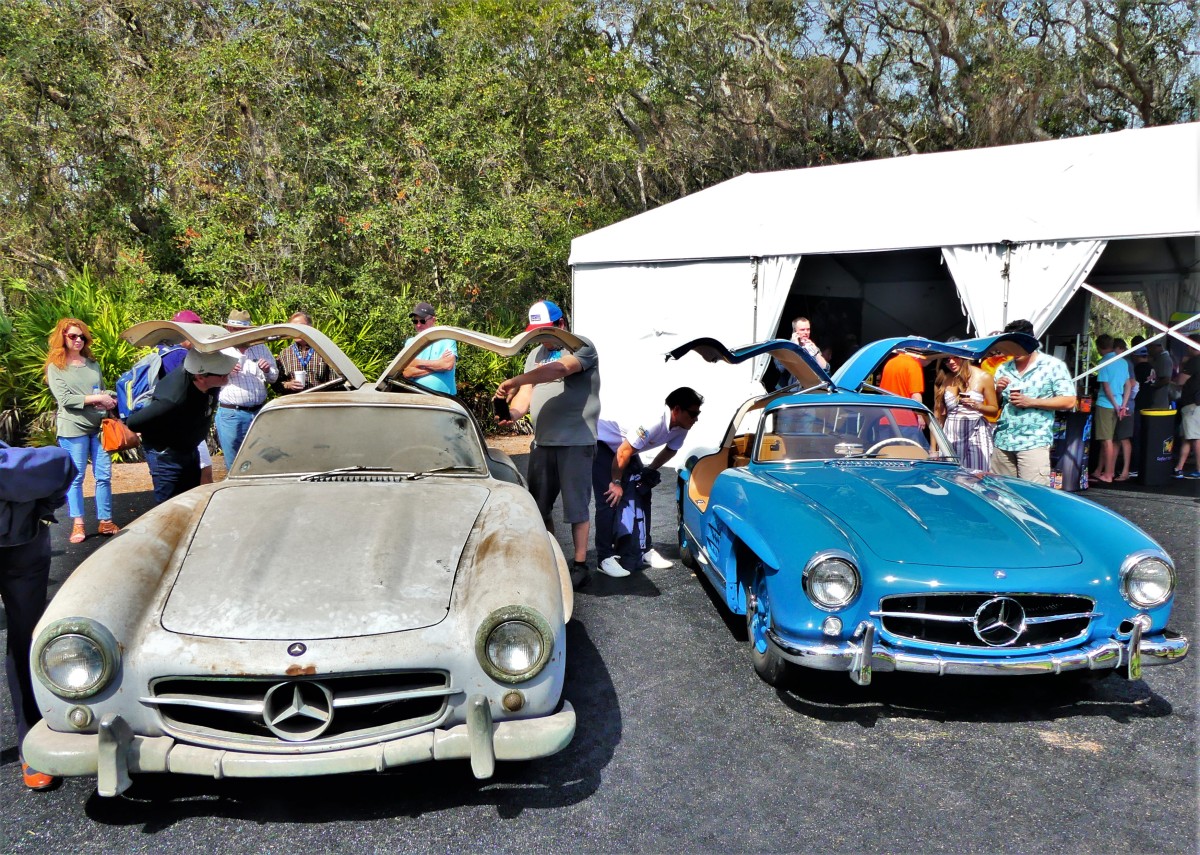
steamed-clean engines to admire…



and glorious paint jobs to behold…




But most enjoyable was sitting on the sidelines watching a parade of auctioned vehicles…


as they were being polished,

and preened…

by teams of attentive handlers in white gloves…

before facing RM Sotheby’s gavel. According to the auctioneer:
Leading RM’s string of 19 individual million-dollar-plus sales and claiming top honors of the 2017 Amelia Island auctions was a striking 1937 Bugatti Type 57S Cabriolet, one of only three examples sporting rare coachwork by Vanvooren of Paris. Offered for public sale for the first time in its 80-year history, the highly original Type 57S sparkled under the auction lights during Saturday’s sale session, commanding $7,700,000. Just moments prior to the Bugatti’s sale, a well-known 1929 Stutz Model M Supercharged Coupe, one of only three supercharged Stutzes in existence, proved demand remains strong for great American Classics at auction, selling for $1,705,000 against a pre-sale estimate of $1/1.2 million. The strong sales price represents a new record for a Stutz at auction.
Friday’s sale session was also one for the books, with the Orin Smith Collection generating $31 million in sales with a 100 percent sell-through. A wonderful showcase of RM Sotheby’s expertise and capabilities in handling private collection auctions, the sale represented the first time RM has hosted a Friday evening sale at Amelia, and provided a fitting tribute to a man beloved by the Amelia crowd, drawing a packed sales room. The group of 63 vehicles was headlined by a stunning 1936 Lancia Astura Cabriolet Series III “Tipo Bocca” at $2,145,000. Other notable sales included:
- the 1956 Bentley S1 Continental Drophead Coupe, just two registered owners from new, shattered both its presale estimate of $700/900,000 and the previous auction record for the model at a final $1,683,000;
- a superbly restored 1933 Rolls-Royce Phantom II Special Newmarket Permanent Sedan soared past its $1,000,000 high estimate at a final $1,237,500; and,
- a 1966 Aston Martin Short-Chassis Volante, the very first example of just 37 built, sold for $1,705,000.
The power of ‘no reserve’ exhibited at Friday’s Orin Smith Collection sale was witnessed again on Saturday with terrific results achieved for a well-known private collection of 10 sporting cars. Highlighting the group, a dramatic two-tone red and black 1956 Maserati A6G/54 Frua Coupe Series III, much-admired by enthusiasts during preview, provided one of the most intense and lively bidding contests of the weekend, eventually selling for $2,365,000 against a pre-sale estimate of $1.6/2.2 million. From the same collection, a 1974 Porsche 911 Carrera RS 3.0 eclipsed its pre-sale estimate of $900,000 – $1.1 million to storm into the record books at a final $1,375,000 (an auction record for the model). Also commanding strong bids were a spectacular 1954 Mercedes-Benz 300 SL Gullwing, which realized $1,358,500, and a stunning 1955 Alfa Romeo 1900C SS Coupe, which brought $1,100,000.
Other noteworthy sales of RM’s 2017 Amelia Island event include:
- the 5,694-mile 1995 Ferrari F50, originally delivered to famed heavyweight Champion boxer, Mike Tyson, sold for an above-estimate $2,640,000;
- a 1938 Graham 97 Supercharged Cabriolet, exquisitely restored by RM Auto Restoration, set a new benchmark for a Graham at auction with its strong $770,000 final price; and,
- ending Saturday’s sale session on a fun note, a 1963 Meyers Manx—the original dune buggy—doubled its pre-sale estimate to sell for a record $68,750.
Collective sales for 135 blue-chip entries generated nearly $71M in sales–producing a record high in the event’s 24-year history…
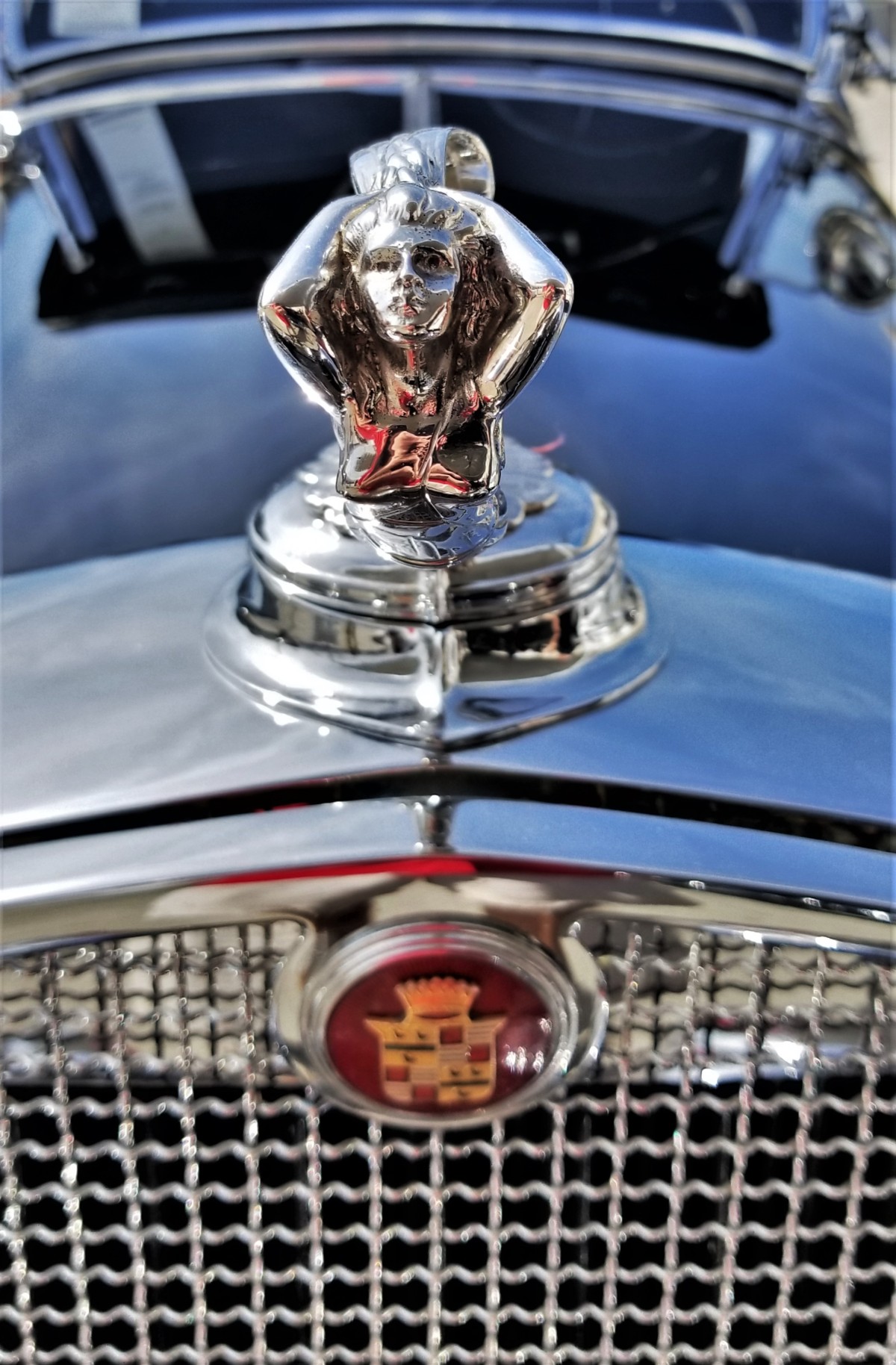
…and at prices that would make a hood ornament blush.

I fear
that being here…
or being there…
is neither here
nor there.
So where
should I care
to be,
if I never dare
to be?

To be clear–
I declare,
that far or near,
or anywhere
I care
to steer,
I may be unaware
of it,
if I only stare
at it.

Leah and I awoke to an overcast day. The forecast promised more of the same, which was fine with me as long as it didn’t rain. We spent the morning searching for a new destination to stretch our legs–maybe find a bike trail, or at the very least, a walking trail not too far from home.
After a late breakfast, we headed south toward Flagler Beach, a salty seaside community with orange sand from crushed coquina…

midway between St. Augustine and Daytona. We were in search of Betty Steflik Memorial Preserve, a cache of 217 acres of marsh and mangroves tucked beneath the Highway 100 causeway,

and bordering the Matanzas River.

A mile or so of boardwalking through the salt marsh was pleasant though unremarkable. However, it offered me time to play with my newly acquired 1.7X tele conversion lens (see Zoom!).


Anticipating a loop around the preserve, we were surprised that the trail dropped us at a different parking lot annexed to the town’s public works complex that was surrounded by dilapidated residential trailers planted only blocks from the beach.

And so we continued our tour of all things industrial and commercial, until we returned to the preserve entrance.

Feeling underwhelmed by our walk-around, I opted for the slow road home, following A1A North on a prayer that the seaside scenery might somehow improve on a somewhat lackluster afternoon.
We passed through nothing of consequence: nondescript shops and eateries, assorted bungalows, big machines for county road repairs, and mainstream subdivisions along the way. But when we reached Palm Coast, the road opened up to a dense maritime hammock of hardwood trees to our left, and I felt compelled to u-turn for a closer look.
We turned into Washington Oaks Garden State Park,

and heard from the gate attendant that the azalea blooms had just reached their peak, and that was enough to pique my interest.

As we completed a self-guided tour of the grounds…
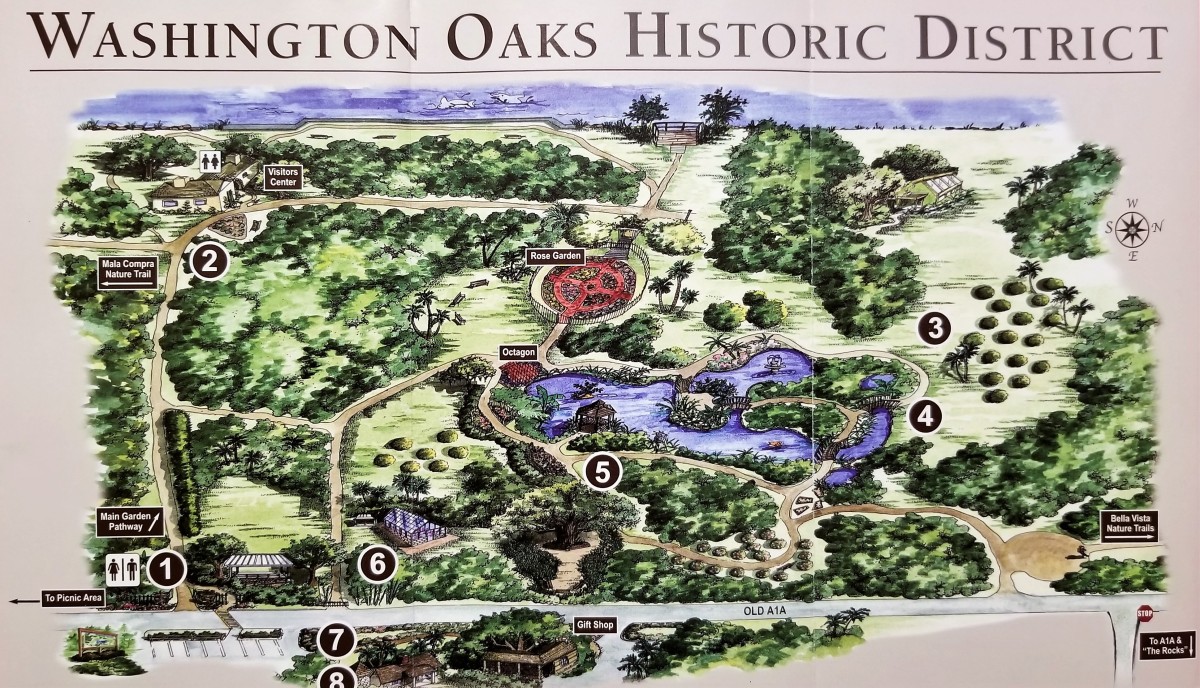
I felt relieved, knowing that our Sunday excursion had been rescued.

The formal gardens were beautifully unusual,

lushly carpeted,

and precisely manicured.

We left the area under partly sunny skies…

knowing that we would return another day to devote more time to the miles of trails through the hammock.
And weather permitting, we will cross the highway to follow the coquina rock formations that line the Atlantic side when the tide is nigh.
